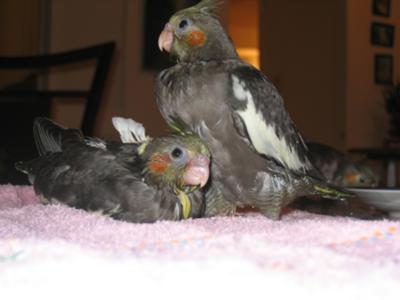Comfort & Warmth
by Reza
(Toronto, Ontario)
I love taking pictures of my birds (I have 7 different "parrots"). This one I took when the two here were about 1 month old. I had been taking a lot of pictures of them, but this one came out special to me.
The one standing is the older brother who is the comfort for the younger brother who is resting under his chest.
I took it with a regular digital camera (Canon a95), and I wanted to take a picture of their brotherly love; of how brothers protect each other.
I put the camera on the table (after they had dinner) so that I had a flat horizon. This way it looked to me that they looked a little taller and larger too. It does show my point, which is how one is resting under the other one's chest.
| HIGHLY RECOMMENDED! Monthly online magazine for digital photographers - with exclusive video tutorials! |
(for convenience links below open in new windows)
Summer is here (for us northern hemisphere people) and the further north you go, the earlier mornings start.
Currently, this is about 4.30 in the morning. The sun is up. The birds are up. And unless we go to some lengths I'm up with them.
I have a rule; no-one should be up when the time on the clock starts with a 5 or less. 4.30 clearly breaks this little rule of mine so I have to resort to stiff measures in order to keep Sonny Sunshine out of my eyes for at least another hour and a half.
The current set up involves a blackout roller blind, one blanket, and two towels. The roller blind covers most of the window, but unfortunately lets through a surprising amount of light at the edges.
So the blanket is employed to block the top edge, and it's supported by two towels that hang, precisely, down the sides to cover the gaps there.
Bliss.
Now, should the blanket or a towel become dislodged in the night all my efforts go to waste. 4.30. Daylight creeps in through the cracks and that's it. Wide awake.
Photographers go to some lengths to control the light too. Darkrooms (obviously dark) and studios.
The reason for this is that good light can make or break a picture and you can't rely on Sonny to do it for you. So inside we go, and out come the artificial lights.
A while ago someone realised that taking photos inside requires quite a lot of light, and so the flashgun was invented. All cameras (well, almost all) have one. And when the light drops - ping! Off goes the flash.
Now you might think this is a good thing, but think again. Flash creates quite a harsh light, and tends to illuminate only the first few feet of a photo. This often leads to bleached out foregrounds and dark backgrounds.
A better approach is to make use of as much light as you can - if it's daytime and you're indoors, sit your subject close to a window to get some natural light. If it's night time, bring in a few lamps.
The more light you can get in the better (unless you're going for a dark and romantic scene, in which case a different approach is called for).
Have a look here for plenty more flash photography tips.
In Reza's photo adding some more light, and moving back from the parrots a bit (and then zooming in) would have reduced the harshness of the flash.
Nonetheless, Reza has managed to capture a nice snap of these two parrots - one I'm sure will find a place in the photo album. Thanks for the submission Reza.
And if anyone knows of a better way to keep the sun out at 4.30am let me know.
Darrell.
Discover the secrets of professional photographers - easy to learn powerful photography techniques


